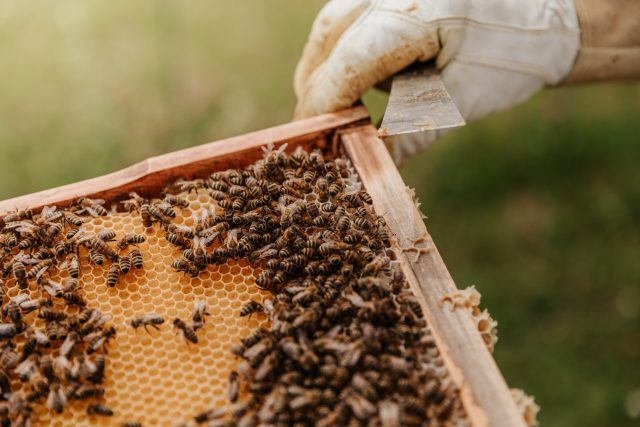Beekeeping has become an increasingly popular hobby, especially among those interested in helping promote bee population growth and pollination. If you want to learn more about beekeeping for pollination, this beginner’s guide provides the essential information needed. This guide will discuss the basics of beekeeping, the necessary equipment for a successful hive, and tips for keeping your bees healthy and productive.
What is Beekeeping?
Beekeeping is an activity where bees are deliberately kept and managed to produce honey, beeswax, royal jelly, and pollination. Beekeepers can increase their bee colonies by actively managing them as well as purchasing new hives. To begin beekeeping for pollination purposes, it is important to understand the basics of bee biology and behavior. Getting started in beekeeping requires some research on the types of bees available and understanding how they operate in different climates. Depending on the type of hive used, a beginner may need to purchase additional supplies, such as a queen excluder or protective clothing. It is also essential that potential keepers become familiar with relevant laws regarding keeping bees in their area before beginning this process.
Benefits of Beekeeping
Beekeeping is an ancient practice that has several modern benefits. One key benefit of beekeeping is the pollination of crops and flowers, which can be done by both hobbyists and large-scale businesses. Beekeepers can choose between two main types of hives: traditional box hives or top-bar hives. Box hives are ideal for large-scale operations as they produce more honey and make it easier to move bees around the area; top-bar hives are perfect for small backyard operations as they provide lots of ventilation and are easier to maintain.
Equipment Needed
Beekeeping for pollination is a vital agricultural process that helps promote plant and flower growth. When farmers rely on natural sources of pollination, such as bees, it can have an extremely positive effect on their yields. Certain pieces of equipment are needed to be successful with beekeeping for pollination. To start beekeeping for pollination, you will need a hive or two where your bees can live and store honey. You will also need protective gear like a veil and gloves to avoid getting stung while managing the hive. Additionally, smokers provide an important tool for calming the bees during maintenance tasks. Smokers use smoke to keep the bees from becoming agitated by masking alarm pheromones released when disturbed.
Setting Up Your Hive
Beekeeping is a great way to encourage local pollination and provide a safe environment for honeybees. For the beginner beekeeper, setting up your hive is an important first step in enjoying the rewards of beekeeping. Starting with high-quality materials and supplies is essential for allowing your bees to thrive and produce delicious honey. When you are ready to start, it’s important to have all your essentials before assembling your hive. A deep box, frames, wax foundation, inner cover, telescoping cover, entrance reducer, and smoker are all necessary pieces of equipment for creating a successful hive. Additionally, gloves and protective clothing will help keep you safe while working around these buzzing creatures. Once you’ve gathered all of the required items, it’s time to assemble your hive!
Maintenance & Care
Beekeeping is an essential practice for pollination and the maintenance of bee colonies. Due to their importance in the ecosystem, beekeepers must be aware of proper maintenance and care techniques to ensure optimal health for their bees. The first step involves choosing the right location for a beehive, which should be in an area with plenty of sunlight but still protected from strong winds. It’s also important to ensure any plants near the hive are free from pesticides or herbicides that may harm bees. Once this is done, beekeepers should provide good ventilation and insulation to maintain a steady temperature within the hive. On a more frequent basis, bees need regular feedings of sugar water as well as supplemental pollen in areas where natural sources are scarce.
Pest Control
Pest control is a necessary aspect of many agricultural and horticultural operations. Without proper pest management, crops may suffer from insects and other pests, reducing crop yields. Beekeeping for pollination can be an effective means to combat certain types of pests while also providing valuable benefits to the environment. This method involves introducing honeybees into fields or gardens to help with pollination, which helps plants produce more flowers, fruits, and vegetables. Additionally, beekeeping has been shown to reduce the incidence of certain pests that feed on plants, such as aphids and mites, by discouraging them from taking up residence. The presence of bees can also help farmers reduce their reliance on chemical-based pesticides that can have negative environmental impacts such as water contamination and soil degradation.
Pollination Strategies
Pollination is the process of transferring pollen from one flower to another, which is essential for healthy plant growth. Beekeeping offers several strategies for ensuring the successful pollination of crops and other plants. One strategy involves introducing bee colonies directly into crop fields or gardens to increase the bees available for pollinating flowers. This method can result in an improved yield and more diverse flowering plants in an area due to increased cross-pollination. Additionally, managed eco-friendly bee hives located near crops can provide additional pollinators without posing a threat to local ecosystems or human health. Another strategy involves encouraging wild bees by providing sources of food and shelter near the garden or field being harvested from.
Conclusion
In conclusion, beekeeping for pollination is a rewarding and fascinating hobby that can be done on any scale. It requires patience, dedication, and knowledge to ensure successful outcomes. Many resources exist both online and in print form to aid beginners in learning the basics of beekeeping and how to best care for their bees. Investing in the right equipment, such as hives and smokers, is also essential. Additionally, creating a safe environment for your bees will provide lasting health benefits while promoting sustainability within your garden or farm. By using these tips and resources, you can start beekeeping today!






























